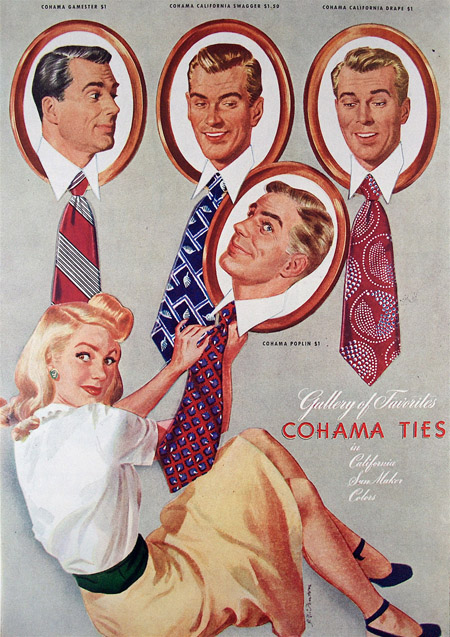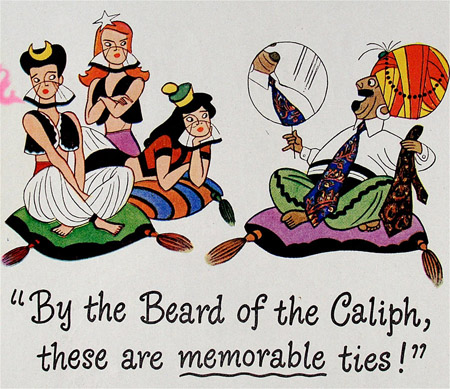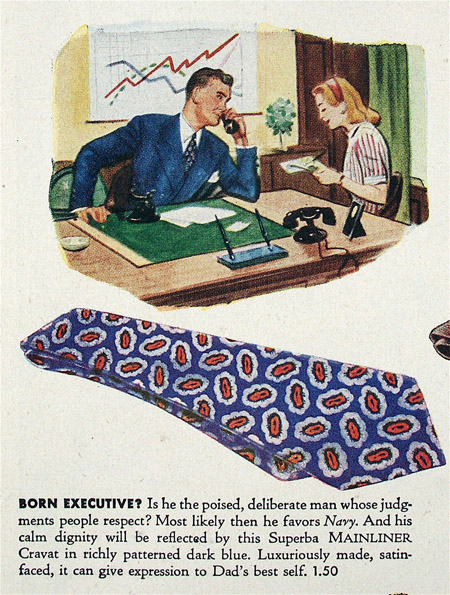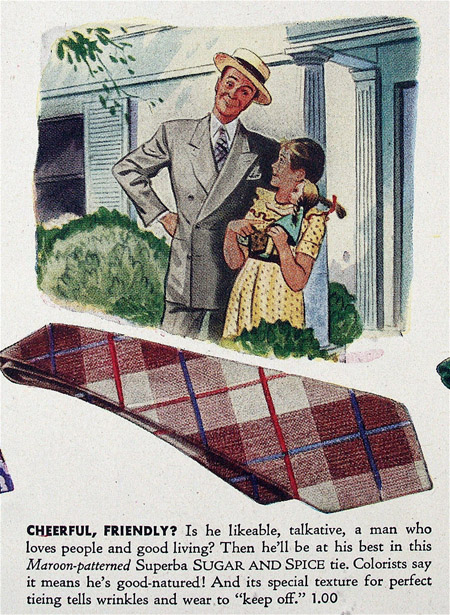Scanning Around With Gene: In Debates, the Tie Makes the Man

The first televised presidential debates, between John F. Kennedy and Richard Nixon in 1960, were broadcast in black and white. So even though 70 million people watched them, the focus seemed to be on Nixon’s sweating too much, not on the color or style of each man’s necktie. In fact, Nixon’s poor showing in those first debates was why he had a heavy hand in forestalling future debates between candidates. Candidates did not debate on national television again until 1976, and they have ever since.
Of course by 1976 the debates were broadcast in color, and that contest, between Jimmy Carter and Gerald Ford, began a small obsession with each candidate’s choice of suit and tie color. Since then, there has been much discussion every four years on just what sort of statement each candidate is making by what they wear around their neck and what sort of knot they use to tie it.
These ads for men’s ties date from 1942 to 1961 and appeared mostly in issues of Esquire magazine. If you click on them you can see larger versions.


In 1984 Ronald Reagan was singled out for wearing a red striped tie, not so much because of the color, but because he used a Windsor knot, a more complicated affair than opponent Walter Mondale’s traditional Four-in-One knot. Reagan became famous for his red ties, which some people think was a factor when, in the 2000 election, newsman Tim Russert first chose the color red to describe states which voted Republican, and blue to describe those that went Democratic.


In 1988, however, both George H. Bush and Michael Dukakis wore red ties, as did John Kerry in 2004, opposite George W. Bush who is noted for his blue ties. Tie choice was important enough that in 1992 when running for his second term against Bill Clinton, the first president Bush hired a fashion consultant, Sig Rogich, who selected a handful of ties to wear throughout the campaign.

The popularity of red ties among presidential candidates may be based in part on red’s natural tendency to bring out color in the face. And of course red has always been considered a bold and forceful choice in tie color: the original “power tie” choice.
In fact, in a current poll running at Hubdub.com, 42% of poll voters expect John McCain to wear a red tie during the first debates this season, 12% say blue, and 28% predict a multi-color choice.


And while tie colors today may be mostly a matter of personal choice and fashion, for many decades necktie color combinations have had significant meaning, especially in the United Kingdom, where military regimens each sport a specific color combination — sort of a code to indicate past loyalties. And in Scotland, of course, there’s that whole tartan pattern thing, where each family clan has a unique color combination and pattern.

In America, though, tie fashion mostly comes and goes along with other trends. The tie has always been a place for men to express their individuality, and as you can see from ads like these from the 1940s, it’s been an opportunity to be a little flamboyant.
Hand-painted ties that are as much a piece of art as fabric have been available since the first time men started wearing neck accessories.


The idea of neckties goes back to 210 B.C. and China’s first emperor. From there, various tribes, cultures, and religious groups adorned their necks with all forms of fabric over the centuries. But like all modern fashion, we have the French to thank for the popularity of neck ties as we know them today. The story goes that Louis XIV was taken by the colorful silk fabric worn by Croatian mercenaries. So a fashion trend began, which soon moved to England.

These “ties” were actually called “cravats” and were more like fluffy scarves wrapped around the neck. It wasn’t until England in the 1800s that ties became associated with sporting clubs and academic institutions, which is what helped the tie really take off as a man’s accessory. Ties became part of the standard uniform of Victorian gentlemen and young schoolboys.


The bow tie came before our modern business tie, when the tuxedo was invented in 1886 in New York (named after the resort Tuxedo Park, where it was first worn).
By the 1920s the necktie as we know it was coming into vogue, and soon long ties hanging down the front of a man’s chest replaced the fancier lace type. At the same time, cowboys were wearing colored bandanas around their necks. (It wasn’t until the 1940s that the Bolo tie came into being.)


There are many more images on page 2!
This article was last modified on May 18, 2023
This article was first published on September 26, 2008



